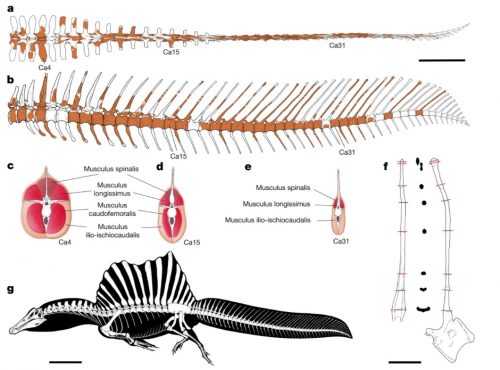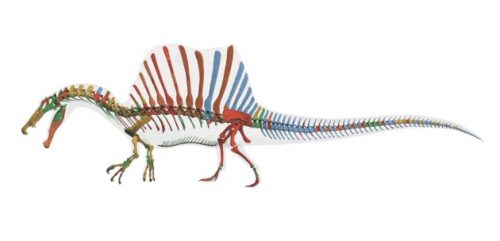Back in 2014, a reconstruction of the full skeleton of Spinosaurus was proudly published. It had been assembled from multiple partial fossils, and was the best approximation of the organism possible.
It was an impressive beast, 15 meters long with that spectacular sail on its back.
At the time that Spinosaurus lived, what is now eastern Morocco was covered with sprawling lakes, rivers and deltas. As a top predator, the dinosaur would have had been among the rulers of an ecosystem teeming with huge crocodile-like animals, massive sawfish and coelacanths the size of cars.
Compared with other dinosaurs in its group — the two-legged, meat-eating creatures known as theropods — Spinosaurus has strikingly short rear legs. Ibrahim’s team interprets this as meaning that the dinosaur walked mainly on four legs. Its centre of gravity would have been relatively far forward, helping it to move smoothly while swimming.
John Hutchinson, a palaeontologist at the Royal Veterinary College of the University of London, is less convinced. He worries about the reliability of cobbling together different specimens to create a single picture of an animal. “We have to be careful about creating a chimera,” he says. “It’s really exciting speculation, but I’d like to see more-conclusive evidence.”
The caveat at the end was prescient. Some pieces were missing from the fossil record. Now that has been changed, and wow, it’s even more spectacular! The old tail wasn’t quite right — it had a broad paddle.

a, b, Caudal series (preserved parts shown in colour) in dorsal view (a) and left lateral view (b). c–e, Reconstructed sequential cross-sections through the tail show proximal-to-distal changes in the arrangement of major muscles. f, Sequential cross-sections through the neural spine of caudal vertebra 23 (Ca23) to show apicobasal changes. g, Skeletal reconstruction. Scale bars, 50 cm (a–e), 10 cm (f), 1 m (g).
OK, this is now my favorite dinosaur.



Ah, but would you say that if you saw it while swimming in your favorite swimming spot?
Personally, I’d be working on breaking the speed of sound in the water.
“This is Spinösaurus” would be a good metal band name.
Marcus Ranum — With the volume set to 11.
With the benefit of hindsight, it occurs to me that all the modern creatures I can think of with a “fin” on their back like that are aquatic- I think of the sailfish, and various newts, to start with. Has anyone considered an aquatic dimetrodon?
“Swimming with the dinosaurs” no thank you! But it’s a lovely piece of work.
felixmagister @4: Yes, that has been proposed for both Dimetrodon and Edaphosaurs but so far there’s little to no evidence supporting the hypothesis.
So what, exactly, is the evolutionary advantage of a huge “fin” like that? Both sharks and dolphins have a “small” one, and considering they’re diffrent lineages its probably some hydrodynamic thing. But why does it need to be so huge? Is it some kind of sexual signalling like a peacocks tail? “Look at how strong I must be to be able to swim while catching so much wind in this ‘sail'”?
robert79@7: There’s a lot of speculation. The spines that support the fin are quite thick, which has led some to speculate that it might have been support for a fat reserve. It’s also been varyingly proposed to have assisted in temperature regulation (IIRC no longer considered to be likely), a display aid, and since its aquatic lifestyle has been discovered it’s been proposed to have acted as a stabilizer for the body while the dinosaur bit at prey, whipped its tail at prey like a modern thresher shark, or was used to herd schools of fish the way modern sailfish use their dorsal fins.
As Charles P. Pierce regularly says on his blog, “Dinosaurs lived then to make us happy now.”
A transitional fossil on the way to being a mosasaur except they weren’t dinosaurs and I think mosasaurs were around before them?
Coincidentally, I saw this earlier today:
Skeleton of a Cretaceous mammal from Madagascar reflects long-term insularity
garydargan @10: Mosasaurs were true lizards, members of the superorder Lepidosauria. They weren’t Archosaurs, much less dinosaurs. They also didn’t arise until tens of millions of years after Spinosaurus was extinct.
The bit that caught my eye was that secondary detached rib bone in its thorax. It has more costae projecting from it than there are coming from the spine itself, and they don’t match up. How did that happen? Was it originally a normal ribcage, and the upper and lower sections gradually separated and went their own developmental ways, or did it emerge ex nihilo from chest cartilage or something?
Do other dinosaurs have that? Do any modern reptiles or other animals?
@Cartomancer
The abdominal ribs are called gastralia and are found in many dinosaurs but were lost by early birds. In terms of modern reptiles, crocodilians and the tuatara have them.
https://archosaurmusings.wordpress.com/2008/11/20/gastralia/
Interestingly, Archaeopteryx had gastralia. I would guess they were lost to lose weight as flight evolved.
Or, maybe, “[as] they were lost
to lose weight, flight [became more likely to develop by subsequent] evolved[ution]”?Someone with a time machine posted some images of Spinosaur discoveries yet to be made . . .
https://twitter.com/sauripus/status/1255706856288210944